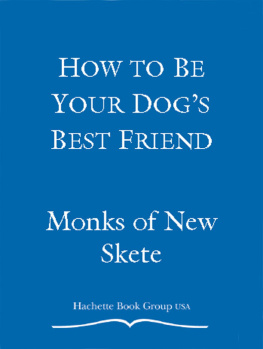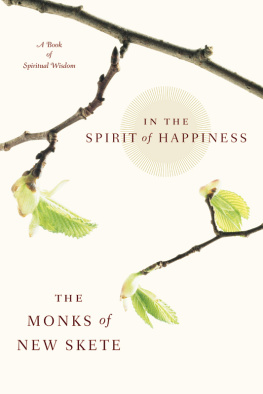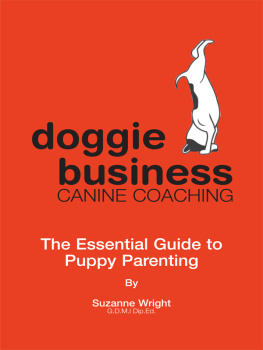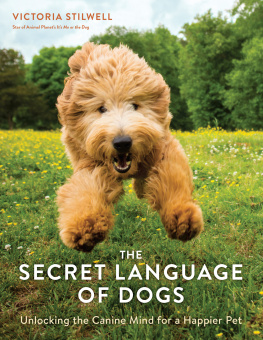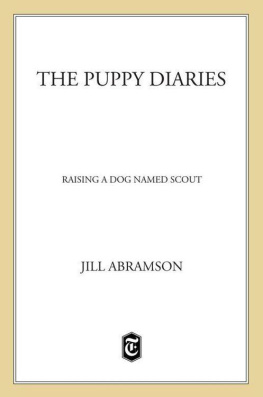THE MONKS OF NEW SKETE
THE ART OF RAISING A PUPPY
COMPLETELY REVISED AND UPDATED

Little, Brown and Company
NEW YORK BOSTON LONDON
The loneliness and solitude of man can be dispersed by spiritual intercourse, but man is of the earth too, and Nature lives in him and holds him fast. She is his mother, and just as in all young things that stray from home there is a yearning after associations which recall the color and the atmosphere of the old home now lost, so does the solitary man seek Nature, a life in Nature, Natures answer, the animal that understands his voice and can respond to it.
F. J. J. Buytendijk, The Mind of the Dog
There is a word from the time of the cathedrals: agape, an expression of intense spiritual affinity with the mystery that is to be sharing life with another life. Agape is love, and it can mean the love of another for the sake of God. More broadly and essentially it is a humble, impassioned embrace of something outside the self, in the name of that which we refer to as God, but which also includes the self and is God. We are clearly indebted as a species to the play of our intelligence; we trust our future to it; but we do not know whether intelligence is reason or whether intelligence is this desire to embrace and be embraced in the pattern that both theologians and physicists call God. Whether intelligence, in other words, is love.
Barry Lopez, Arctic Dreams: Imagination and Desire in a Northern Landscape
Abba Xanthias said, A dog is better than I am, for he has love and does not judge.
The Sayings of the Desert Fathers

Monasteries are not as otherworldly as you might imagine. If they appear secluded and removed from the mainstream of societys activity, it is only because they attempt to create a climate that fosters an authentic engagement with life at its most profound and human level, something often lost amid the noise and distraction of todays world. When we are quiet enough, freed from all our inner noise and chatter, we can see with new respect the natural beauty and wisdom of the world around us and appreciate our ties to it. Such perceptive silence opens up our lives to healthy reverence and awe for all things; it creates a capacity for acceptance that is both humanizing and life-giving.
So what does all of this have to do with raising a puppy? A great deal, we believe. Our monastery is set in a quiet, rural area in upper New York State. For more than forty years, as part of an effort to support ourselves, we have been actively involved in the breeding and raising of German shepherd dogs. We have also operated a training program that is open to dogs of all breeds. During this time we have worked closely with numerous professional breeders, trainers, and veterinarians to deepen our understanding of all facets of canine care.
We have learned that our monastic environment offers us a unique perspective. Here we are forced to reexamine our attitudes about everything, including dogs. We are constantly challenged to become more open to the language dogs use to communicate with us. This experience confirms our deepest intuitions about the relationship of human beings not only with their dogs but with every aspect of the world in which they live.
In our book How to Be Your Dogs Best Friend, we took what we had learned about dog behavior and training and made it available to other people and their dogs in the varied and diverse environments in which they live. We hoped to foster in our readers a more realistic understanding of their dogs and an increased awareness of the benefits of canine companionship. Drawing on our own experience here at New Skete, we described how dog training actually goes far beyond the elementary instruction of basic obedience commands; it must encompass a whole new attitude and lifestyle with your dog. It must touch on the levels of a dogs own life that have often been ignored. This is why we explored the broader issue of companionship itself.
We still firmly believe in this approach, and the years since the publication of our first book have deepened our understanding and commitment to the principles we discussed there. We continue to be energetically involved in the breeding of healthier, sounder German shepherds, as well as in working with owners of many breeds on a training basis. These are demanding tasks, and the fact that we are a close-knit community permits us to pay careful attention to these concerns and learn from them.
But we still see that, elsewhere, ignorance on a vast scale continues to make dogs the victims of human thoughtlessness and abuse. As anyone seriously involved in the field knows, working with dogs and their owners is a bittersweet experience. It regularly forces us to witness the collision of philosophy with reality. The remarkable little puppy so filled with the capacity for life and companionship one week can easily become an incontinent, destructive, and hyperactive annoyance the next. We have seen this happen repeatedly. Poor management all too often leads to irritating or even dangerous behavior problems that quickly sever the human-dog bond before it ever has the chance to develop. While most of the dogs we deal with are intelligent, happy, and well-adjusted, some are not. Every day we encounter dogs who have serious behavior problems and for whom obedience training has been described as the last chance. Usually they clearly manifest signs of a bad start in life: poor breeding, limited handling and socialization as puppies, and lack of owner understanding concerning the importance of proper diet, exercise, discipline, and obedience training. As we work with these cases, we cannot help being convinced that most of these dogs, had they been treated more carefully and intelligently as puppies, would never have developed the problems that now beset them and their owners.
If we look honestly at the way many people manage their dogs today, we are faced with a staggering reflection of irresponsibility and lack of compassion. It is difficult to refer to a dog as mans best friend when more than six million unwanted adult dogs and puppies are euthanized every year. We are not speaking here of the humane killing of animals done out of a sense of responsible stewardship but of the massive human negligence that leads to euthanasia.
For those who doubt the serious implications of this situation, a trip to the local animal shelter can be a real eye-opener. We recall one client who dismissed our advice about spaying her female shepherd, explaining she felt it was important for her children to have the experience of seeing puppies born. When we asked her how she intended to care for and give homes to the puppies, she responded that she really had not thought about it at all and that she would probably leave them at the local humane society when it was time for them to be weaned. We then asked her what value such an experience would have if the principal lesson her children would learn is that puppies are cute little playthings who, when sufficiently used, may then be conveniently disposed of. Fortunately, our questioning convinced her of her faulty thinking, and she left with a new respect for the implications of bringing puppies into the world.
In our view, the dog is not a possession, a personal commodity to be used solely for our own amusement or ego gratification. Rather, he is a living, autonomous yet highly social pack-oriented creature who has an amazing capacity for companionship and love. Your role in determining your connection with your own dog is a vital one. Capacity is precisely thata natural potential. A good relationship with your dog can be established only if there is an enlightened commitment to working with his proven needs, instincts, behavior patterns, and, yes, capacities.


